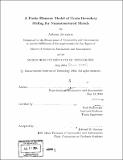A finite element model of grain boundary sliding for nanostructured metals
Author(s)
Jérusalem, Antoine, 1979-
DownloadFull printable version (7.300Mb)
Other Contributors
Massachusetts Institute of Technology. Dept. of Aeronautics and Astronautics.
Advisor
Raúl Radovitzky.
Terms of use
Metadata
Show full item recordAbstract
Nanocrystalline metals, i.e., polycrystalline metals with grain sizes in the nanometer range, have elicited significant interest recently due to their potential for achieving higher material strength in combination with increased formability at lower temperatures and higher strain rates, among other potential performance improvements in the material properties. In addition, there is a growing body evidence of unique deformation mechanisms furnishing a qualitatively different mechanical behavior in materials structured at the nanometer scale. In particular, the expected increase of the yield strength with the refinement of the microstructure appears to level off at grain sizes of the order of 10 to 50 nm and reverts to a decrease of strength with further reduction of grain size. Experimental studies and atomistic simulations have provided evidence of this peculiar behavior. In this work, we propose a continuum model describing the competing deformation mechanisms believed to determine the effective response of nanocrystalline materials. A phenomenological model considering grain boundary sliding and accommodation as uncoupled plastic dissipative deformation mechanisms is formulated to describe the constitutive behavior of grain boundaries. Tensile test simulations using the proposed model reproduce the inverse trend in the grain-size dependency of the macroscopic yield stress predicted by atomistic simulations and experiments. Even more noteworthy is the finding that the numerically predicted grain-size dependency of the yield stress shows a linear relation to the inverse square root of the grain size, a phenomenon identified as the inverse Hall-Petch effect. The importance of this result is lastly enhanced by the prediction (cont.) from the model that the observed discrepancy between molecular dynamics and experimental results may be strongly related to the deformation rate.
Description
Thesis (S.M.)--Massachusetts Institute of Technology, Dept. of Aeronautics and Astronautics, 2004. Includes bibliographical references (p. 69-76).
Date issued
2004Department
Massachusetts Institute of Technology. Department of Aeronautics and AstronauticsPublisher
Massachusetts Institute of Technology
Keywords
Aeronautics and Astronautics.